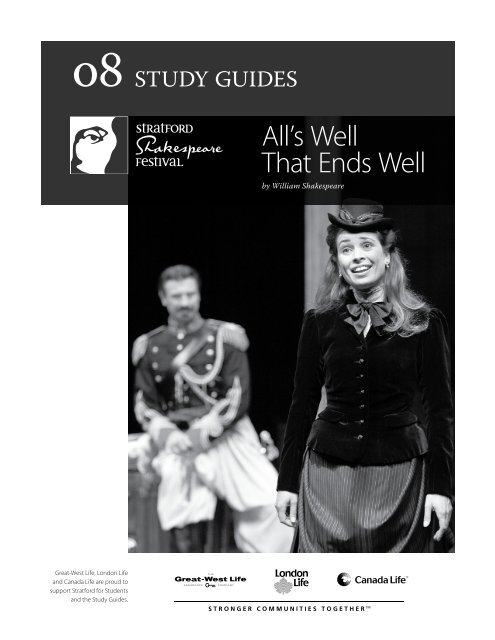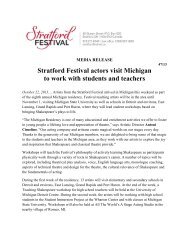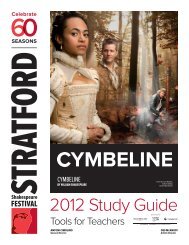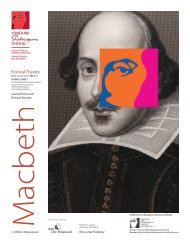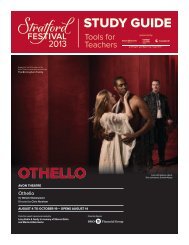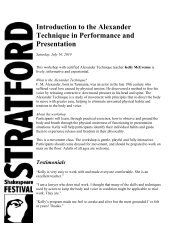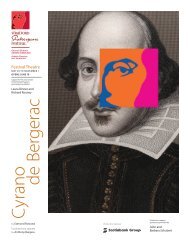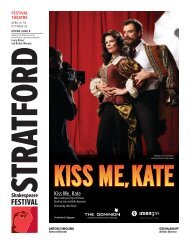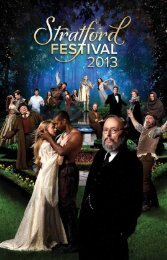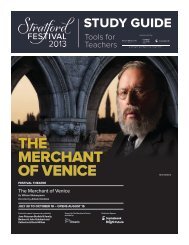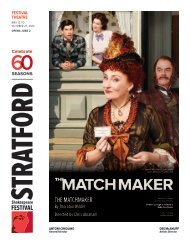All's Well That Ends Well - Stratford Festival
All's Well That Ends Well - Stratford Festival
All's Well That Ends Well - Stratford Festival
You also want an ePaper? Increase the reach of your titles
YUMPU automatically turns print PDFs into web optimized ePapers that Google loves.
o8 Study Guides<br />
All’s <strong>Well</strong><br />
<strong>That</strong> <strong>Ends</strong> <strong>Well</strong><br />
by William Shakespeare<br />
Great-West Life, London Life<br />
and Canada Life are proud to<br />
support <strong>Stratford</strong> for Students<br />
and the Study Guides.
Table of Contents<br />
Introduction<br />
1 The <strong>Stratford</strong> Shakespeare <strong>Festival</strong> Story<br />
The Play: About All’s <strong>Well</strong> <strong>That</strong> <strong>Ends</strong> <strong>Well</strong><br />
2 The Playwright: William Shakespeare<br />
2 Synopsis<br />
3 Timeline: Shakespeare’s Life and World Events<br />
4 Sources and Production History<br />
5 Cast of Characters<br />
5 Discussion Topics<br />
The Production: All’s <strong>Well</strong> <strong>That</strong> <strong>Ends</strong> <strong>Well</strong> at the <strong>Stratford</strong> Shakespeare <strong>Festival</strong><br />
6 Cast List<br />
6 Production Choices<br />
Activities<br />
7<br />
Resources<br />
8 Selected Bibliography<br />
8 Online Resources<br />
Cover photography: Daniela Vlaskalic as Helena, with Juan Chioran<br />
(background) as Parolles. Photo: David Hou.
Introduction<br />
The <strong>Stratford</strong> Story<br />
<strong>That</strong> <strong>Stratford</strong>, Ontario, is the home of the largest classical repertory theatre in<br />
North America is ultimately attributable to the dream of one man, <strong>Stratford</strong>-born<br />
journalist Tom Patterson.<br />
In the early 1950s, seeing the economy of his home town endangered by the<br />
withdrawal of the railway industry that had sustained it for nearly 80 years,<br />
Patterson conceived the idea of a theatre festival devoted to the works of William<br />
Shakespeare. His vision won the support not only of <strong>Stratford</strong> City Council and<br />
an enthusiastic committee of citizens, but also of the legendary British actor and<br />
director Tyrone Guthrie, who agreed to become the proposed festival’s first Artistic<br />
Director. The <strong>Stratford</strong> Shakespearean <strong>Festival</strong> of Canada was incorporated as a<br />
legal entity on October 31, 1952. A giant canvas tent was ordered from a firm in<br />
Chicago, and in the parklands by <strong>Stratford</strong>’s Avon River work began on a concrete<br />
amphitheatre at the centre of which was to be a revolutionary thrust stage created<br />
to Guthrie’s specifications by internationally renowned theatrical designer<br />
Tanya Moiseiwitsch.<br />
From the balcony of that stage, on the night of July 13, 1953, actor Alec Guinness<br />
spoke the opening lines of Richard III: “Now is the winter of our discontent/ Made<br />
glorious summer by this sun of York.” Those words marked the triumphant end to<br />
what had sometimes seemed a hopeless struggle against the odds to turn Patterson’s<br />
dream into a reality – and the beginning of an astonishing new chapter in Canadian<br />
theatre history. The other production of that inaugural six-week season, a moderndress<br />
version of All’s <strong>Well</strong> <strong>That</strong> <strong>Ends</strong> <strong>Well</strong>, opened the following night, confirming<br />
the opinion of celebrated novelist Robertson Davies that the new <strong>Festival</strong> was an<br />
achievement “of historic importance not only in Canada, but wherever theatre is<br />
taken seriously – that is to say, in every civilized country in the world.”<br />
Time proved the truth of Davies’ words, for the <strong>Festival</strong>’s pillared, porticoed<br />
thrust stage revolutionized the performance of classical and contemporary<br />
theatre in the latter half of the 20th century and inspired the design of more than<br />
a dozen other major venues around the world, including the Guthrie Theatre<br />
in Minneapolis, the Beaumont Theatre at Lincoln Centre and, in England, the<br />
Chichester <strong>Festival</strong> Theatre, the Crucible Theatre in Sheffield and the Olivier<br />
Theatre at the Royal National Theatre in London. Over the years, the <strong>Festival</strong> has<br />
made some amendments to the original design of Moiseiwitsch’s stage, without<br />
changing its essential format.<br />
At the end of the 1956 season, the giant canvas tent that had housed the<br />
<strong>Festival</strong>’s first four seasons was dismantled for the last time to make way for a<br />
new and permanent facility to be erected around the existing stage. Designed by<br />
architect Robert Fairfield, the new building would be one of the most distinctive in<br />
the world of the performing arts: its circular floor plan and crenellated roof paying<br />
striking tribute to the <strong>Festival</strong>’s origins under canvas.<br />
In the years since its first season, the <strong>Stratford</strong> Shakespeare <strong>Festival</strong> has set<br />
benchmarks for the production not only of Shakespeare, Molière, the ancient<br />
Greeks and other great dramatists of the past, but also of such 20th-century<br />
masters as Samuel Beckett, Bertolt Brecht, Anton Chekhov, Henrik Ibsen, Eugene<br />
O’Neill, and Tennessee Williams. In addition to acclaimed productions of the<br />
best in operetta and musical theatre, it has also showcased –and in many cases<br />
premièred – works by outstanding Canadian and other contemporary playwrights.<br />
Its artists have included the finest actors, directors and designers in Canada, as<br />
well as many from abroad. Among the internationally renowned performers who<br />
Top to bottom: 1953, the tent in which the first productions<br />
at the <strong>Stratford</strong> <strong>Festival</strong> were staged; A view of the <strong>Festival</strong><br />
Theatre as it stands today; 1954, the interior of the tent in which<br />
productions were staged before the permanent facility was built;<br />
The <strong>Festival</strong> Theatre stage as it appears today.<br />
have graced its stages are Alan Bates, Brian Bedford, Douglas Campbell, Len Cariou, Brent Carver, Hume Cronyn, Colm Feore, Megan<br />
Follows, Lorne Greene, Paul Gross, Uta Hagen, Julie Harris, Martha Henry, William Hutt, James Mason, Eric McCormack, Loreena<br />
McKennitt, Richard Monette, John Neville, Nicholas Pennell, Christopher Plummer, Sarah Polley, Douglas Rain, Kate Reid, Jason<br />
Robards, Paul Scofield, William Shatner, Maggie Smith, Jessica Tandy, Peter Ustinov, and Al Waxman.<br />
Drawing audiences of more than 500,000 each year, the <strong>Festival</strong> season now runs from April to November, with productions being<br />
presented in four unique theatres, and includes a full program of Beyond the Stage activities including concert recitals, discussion<br />
sessions, lectures, and readings by celebrated authors. It offers an extensive program of educational and enrichment activities for<br />
students, teachers, and other patrons, and operates its own in-house school of professional artist development: The Birmingham<br />
Conservatory for Classical Theatre.<br />
<strong>Stratford</strong> Shakespeare <strong>Festival</strong> ~ Study Guide ~ ALL’S WELL THAT ENDS WELL 2008 1
ABOUT ALL’S WELL THAT ENDS WELL<br />
The Playwright<br />
WILLIAM SHAKESPEARE<br />
Born in <strong>Stratford</strong>-upon-Avon, a small Warwickshire town, in 1564,<br />
William Shakespeare was the eldest son of John Shakespeare, a glover,<br />
and Mary Arden, the daughter of a wealthy farmer. The exact date of his<br />
birth is unknown, but baptismal records point to it being the same as that<br />
of his death, April 23. He probably attended what is now the Edward VI<br />
Grammar School, where he would have studied Latin literature, and at 18,<br />
he married a farmer’s daughter, Anne Hathaway, with whom he had three<br />
children: Susanna, born in 1583, and, two years later, the twins Hamnet<br />
(who died in childhood) and Judith.<br />
Nothing further is known of his life until 1592, when his earliest known<br />
play, the first part of Henry VI, became a hit in London, where Shakespeare<br />
was now working as an actor. Soon afterwards, an outbreak of the plague<br />
forced the temporary closure of the theatres, and Shakespeare turned for<br />
a while to writing poetry. By 1594, however, he was back in the theatre,<br />
acting with the Lord Chamberlain’s Men. He quickly established himself as<br />
one of London’s most successful dramatists, with an income that enabled<br />
him, in 1957, to buy a mansion back in <strong>Stratford</strong>. In 1599 he became a<br />
shareholder in London’s newly built Globe Theatre.<br />
In 1603, Shakespeare’s company was awarded a royal patent, becoming known as the King’s Men. Possibly as early as 1610,<br />
the playwright retired to his home in <strong>Stratford</strong>-upon-Avon, living there – and continuing to invest in real estate – until his<br />
death on April 23, 1616. He is buried in the town’s Holy Trinity Church.<br />
In the first collected edition of his works in 1623, fellow dramatist Ben Jonson called him a man “not of an age, but for all<br />
time.” Not only did Shakespeare write some of the most popular plays of all time, but he was a very prolific writer, writing 38<br />
(canonically accepted) works in 23 years. His work covered many subjects and styles, including comedies, tragedies, histories,<br />
and romances, all bearing his hallmark expansive plots, extraordinary language, and humanist themes. Shakespeare enjoyed<br />
great popularity in his lifetime, and 400 years later, he is still the most produced playwright in the world.<br />
Plot Synopsis<br />
Helena, orphan daughter of a famous physician, has been brought up in the house of the Countess of Rossillion. She falls in<br />
love with Bertram, the son of the countess.<br />
At the French Court, on his way to war, Bertram finds the King of France dangerously ill of a supposedly incurable disease.<br />
Helena, hearing of his illness, comes to court and offers to cure him with one of her father’s remedies on condition that, when<br />
cured, he will give her in marriage to the man of her choice. The King accepts her conditions; she cures him and chooses<br />
Bertram as her husband.<br />
As the King’s ward, Bertram must obey but he accepts grudgingly. Immediately after the marriage, he and his boastful<br />
follower Parolles set off for Italy to enlist in the service of the Duke of Florence. Helena receives a letter with a cruel message:<br />
“When thou canst get the ring upon my finger which never shall come off, and show me a child begotten of thy body that I am<br />
father to, then call me husband.”<br />
Withdrawing secretly from the Countess’ house and coming to Florence disguised as a pilgrim, Helena discovers Bertram<br />
engaged in dalliance with Diana, the daughter of her hostess. She arranges to replace Diana in bed on Bertram’s next visit.<br />
Taking a ring from him, she gives in exchange a ring given her by the King of France. When the war is over Bertram, hearing<br />
that Helena is dead, returns to France, still wearing the ring. The King sees it and as Bertram cannot explain how he came to<br />
have it, the King accuses him of having killed Helena. Helena arrives and confronts Bertram with another ring, given her by<br />
him in Florence. Pregnant by Bertram, she asks that he accept her as his wife now that the conditions of his letter have been<br />
met, and he agrees to do so.<br />
<strong>Stratford</strong> Shakespeare <strong>Festival</strong> ~ Study Guide ~ ALL’S WELL THAT ENDS WELL 2008 2
ABOUT ALL’S WELL THAT ENDS WELL<br />
A Shakespearean Timeline<br />
1558 Elizabeth I crowned.<br />
1564 William Shakespeare born.<br />
1572 Actors not under the protection of a patron declared rogues and vagabonds.<br />
1576 “The Theatre”, the first public playhouse in London, opens.<br />
1577 “The Curtain”, London’s second playhouse, opens.<br />
1578 James VI (later James I of England) takes over government of Scotland.<br />
1579 Publication of North’s English translation of Plutarch’s Lives of the Noble Grecians and Romans.<br />
1580 Francis Drake returns in triumph form his voyage around the world; travelling players perform at <strong>Stratford</strong>.<br />
1582 Shakespeare marries Anne Hathaway; Susanna is born six months later and the twins Hamnet and Judith in 1585.<br />
1587 “The Rose” theatre opens in London. Mary Queen of Scots is executed.<br />
1588 Spanish Armada defeated.<br />
1589 Shakespeare finds work as an actor in London; he lives apart from his wife for 21 years.<br />
1590-1591 The Two Gentlemen of Verona, The Taming of the Shrew.<br />
1591 2 Henry VI, 3 Henry VI.<br />
1592 Thousands die of plague in London; theatres closed. 1 Henry VI, Titus Andronicus, Richard III.<br />
1593 The Comedy of Errors.<br />
1594 Shakespeare becomes a shareholder of his theatre company, The Lord Chamberlain’s Men.<br />
1594 Love’s Labour’s Lost.<br />
1595 Richard II, Romeo and Juliet, A Midsummer Night’s Dream.<br />
1596 Shakespeare’s son, Hamnet, dies.<br />
1596-1597 King John, The Merchant of Venice, 1 Henry IV.<br />
1597-1598 The Merry Wives of Windsor, 2 Henry IV, Much Ado About Nothing.<br />
1598 “The Globe” theatre built.<br />
1598-1599 Henry V, Julius Caesar.<br />
1599-1600 As You Like It.<br />
1600-1601 Hamlet, Twelfth Night.<br />
1601 Shakespeare’s patron arrested for treason following the Essex rebellion; he is later pardoned.<br />
1602 Troilus and Cressida.<br />
1603 Queen Elizabeth dies and is succeeded by James I; Shakespeare’s theatre company becomes the King’s Men.<br />
1603 Measure for Measure, Othello.<br />
1604 Work begins on the King James bible.<br />
1604-1605 All’s <strong>Well</strong> <strong>That</strong> <strong>Ends</strong> <strong>Well</strong>, Timon of Athens, King Lear (Q)<br />
1606 Macbeth, Antony and Cleopatra.<br />
1607 Pericles, Prince of Tyre.<br />
1608 Coriolanus.<br />
1609 The Winter’s Tale.<br />
1610 King Lear (F), Cymbeline.<br />
1610 Shakespeare retires to <strong>Stratford</strong>-upon-Avon.<br />
1611 The Tempest.<br />
1611 King James version of the bible published.<br />
1613 Henry VIII (All is True), The Two Noble Kinsmen.<br />
1613 “The Globe” theatre burns down.<br />
1616 Shakespeare dies in <strong>Stratford</strong>-upon-Avon.<br />
1623 The first folio of Shakespeare’s collected plays is published.<br />
* some dates are approximate<br />
<strong>Stratford</strong> Shakespeare <strong>Festival</strong> ~ Study Guide ~ ALL’S WELL THAT ENDS WELL 2008 3
ABOUT ALL’S WELL THAT ENDS WELL<br />
Sources and Production History<br />
ABOUT THE PLAY<br />
All’s <strong>Well</strong> <strong>That</strong> <strong>Ends</strong> <strong>Well</strong>, along with Troilus and Cressida and Measure for Measure, is one of Shakespeare’s so-called<br />
“problem” plays. Although it is technically classified with the comedies when it was first published in the First Folio (1623),<br />
the central characters are placed in more painful and less light-hearted situations than those in Shakespeare’s earlier, more<br />
romantic comedies.<br />
Although external evidence is lacking to pinpoint its exact date of composition, internal evidence places it firmly as one of<br />
Shakespeare’s early Jacobean efforts (1603-1605).<br />
SOURCES AND ORIGINS<br />
Shakespeare based the main plot about Bertram and Helena on a tale from Boccaccio’s Decameron (1353) (a translation of<br />
which is found in William Painter’s Palace of Pleasure (1575)). Lord Lafew, the Countess of Rossillion, and Parolles are all<br />
inventions of Shakespeare’s – the character of Parolles descending from the braggart soldier character of Roman comedy.<br />
The plot is strongly related to folk tale and fairy tale, being in fact a combination of two traditional episodes: “the healing of<br />
the king” and “the fulfillment of the tasks.” In the first, a person gains a desired goal by knowing the secret of a king’s illness<br />
and by curing him. In the second, a person is set a series of apparently impossible tasks to be performed before s/he can live<br />
happily; against all probability s/he performs these tasks and claims the reward, which is then granted.<br />
ALL’S WELL THAT ENDS WELL IN PERFORMANCE<br />
All’s <strong>Well</strong> was infrequently performed in the 16th, 17th and 18th centuries.<br />
19th century performances of the play tended to be heavily adapted – toning down what was deemed as Helena’s sexual<br />
aggressiveness. In recent decades the play has become much more popular and has been frequently produced. The <strong>Stratford</strong><br />
<strong>Festival</strong>’s 1953 production (and 1959 <strong>Stratford</strong>, England revival), was, indeed, one of the productions which re-popularized the<br />
play. Directed by Tyrone Guthrie, with minimal cuts or alterations to the script and featuring modern dress, the production<br />
was revelatory and played to sold-out crowds.<br />
STRATFORD Shakespeare FESTIVAL PRODUCTION HISTORY<br />
This is the sixth production of All’s <strong>Well</strong> <strong>That</strong> <strong>Ends</strong> <strong>Well</strong> at the <strong>Stratford</strong> Shakespeare <strong>Festival</strong>.<br />
1953 (<strong>Festival</strong> Theatre): directed by Tyrone Guthrie and designed by Tanya Moiseiwitsch. The cast included Alec Guinness as<br />
the King of France, Irene Worth as Helena, Michael Bates as Lafew, Douglas Campbell as Parolles, Timothy Findley as French<br />
Officer, Amelia Hall as Widow, Donald Harron as Bertram, William Hutt as Minister of State, William Needles as Rinaldo and<br />
Eleanor Stuart as the Countess of Rossillion.<br />
1977 (<strong>Festival</strong> Theatre): directed by David Jones and designed by Tanya Moiseiwitsch. The cast included William Hutt as the<br />
King of France, Martha Henry as Helena, Graeme Campbell as the Duke of Florence, Peter Donaldson as Page to Bertram,<br />
Lewis Gordon as Rinaldo, Richard Monette as Parolles, Nicholas Pennell as Bertram, Margaret Tyzack as the Countess of<br />
Rossillion, Tom Wood as Lavatch and Leslie Yeo as Lafew.<br />
1982 (Tom Patterson Theatre): directed by Richard Cottrell and designed by Christina Poddubiuk. The cast included Joseph<br />
Shaw as the King of France, Fiona Reid as Helena, Charmion King as the Countess of Rossillion, Paul Massie as Lafew, Diego<br />
Matamoros as Parolles, Seana McKenna as Diana and John Novak as Bertram.<br />
1988 (Avon Theatre): directed by Peter Moss and designed by Christina Poddubiuk. The cast included Joseph Shaw as the<br />
King of France, Lucy Peacock as Helena, Richard Curnock as Lafew, Allan Gray as Lavatch, Nigel Hamer as Bertram, Bernard<br />
Hopkins as Parolles, Eric McCormack as Dumain (younger), Keith Thomas as Dumain (elder) and Susan Wright as the<br />
Countess of Rossillion.<br />
2002 (<strong>Festival</strong> Theatre): directed by Richard Monette and designed by Ann Curtis. The cast included William Hutt as the<br />
King of France, Lucy Peacock as Helena, Domini Blythe as the Countess of Rossillion, Benedict Campbell as Lavatch, Bernard<br />
Hopkins as Lafew, Tim MacDonald as Parolles, David Snelgrove as Bertram, Stephen Russell as the Duke of Florence and Sara<br />
Topham as Diana.<br />
<strong>Stratford</strong> Shakespeare <strong>Festival</strong> ~ Study Guide ~ ALL’S WELL THAT ENDS WELL 2008 4
ABOUT ALL’S WELL THAT ENDS WELL<br />
Cast of Characters<br />
King of France<br />
Bertram, Count of Rossillion<br />
Countess of Rossillion, mother to Bertram<br />
Helena, an orphan protected by the Countess<br />
Lafew, an old lord<br />
Parolles, a follower of Bertram<br />
Rynaldo, a steward<br />
Lavatch, a clown<br />
Duke of Florence<br />
Two lords, the brothers Dumaine, French lords,<br />
later captains serving the Duke of Florence<br />
Widow Capilet of Florence<br />
Diana, daughter to the widow<br />
Mariana, friend to the widow<br />
French Gentleman<br />
Page<br />
Messenger<br />
Lords, Attendants, Soldiers, etc., French and Florentine<br />
Costume sketch by Christina Poddubiuk for Parolles.<br />
Suggested Topics for Discussion<br />
1. Have your students read All’s <strong>Well</strong> <strong>That</strong> <strong>Ends</strong> <strong>Well</strong>: discuss what they expect to see on the stage when they attend the<br />
performance of All’s <strong>Well</strong> <strong>That</strong> <strong>Ends</strong> <strong>Well</strong> at the <strong>Stratford</strong> <strong>Festival</strong>. Have each student make a list of predictions about what they<br />
expect. Save these predictions. After seeing the show, revisit them to see how they compared to the actual production.<br />
2. Have your students make a story map or a story board outlining the main events of the play. (This may be used later in<br />
group activities.)<br />
3. All’s <strong>Well</strong> <strong>That</strong> <strong>Ends</strong> <strong>Well</strong> has appealed to artists and audiences around the world for 400 years. What do your students think<br />
the play’s message is What parts did they respond to most Were there parts they wished were different How<br />
4. Have your students create a character web showing how all the characters are connected to each other. Discuss the<br />
complexity of these relationships and how they affect the progression of the play.<br />
<strong>Stratford</strong> Shakespeare <strong>Festival</strong> ~ Study Guide ~ ALL’S WELL THAT ENDS WELL 2008 5
ABOUT ALL’S WELL THAT ENDS WELL<br />
2008 <strong>Stratford</strong> Shakespeare <strong>Festival</strong> Production<br />
<strong>Festival</strong> Theatre<br />
June 19 – August 23, 2008<br />
Artistic Team<br />
Director......................................................................................................................................................................................................................................... Marti Maraden<br />
Designer..............................................................................................................................................................................................................................Christina Poddubiuk<br />
Lighting Designer......................................................................................................................................................................................................................Louise Guinand<br />
Cast List<br />
At Rossillion<br />
Countess of Rossillion..........................................................................................................................................................................................................................Martha Henry<br />
Bertram, Count of Rossillion...................................................................................................................................................................................................................... Jeff Lillico<br />
Parolles....................................................................................................................................................................................................................................................... Juan Chioran<br />
Lavache.........................................................................................................................................................................................................................................................Tom Rooney<br />
Helena................................................................................................................................................................................................................................................. Daniela Vlaskalic<br />
Rynaldo........................................................................................................................................................................................................................................................... John Innes<br />
Maid...................................................................................................................................................................................................................................................... Shelley Simester<br />
In Paris<br />
King of France.......................................................................................................................................................................................................................................Brian Dennehy<br />
Lafew..................................................................................................................................................................................................................................................Stephen Ouimette<br />
First Lord Dumaine.................................................................................................................................................................................................................................. Ben Carlson<br />
Second Lord Dumaine...................................................................................................................................................................................................................Patrick McManus<br />
Doctor....................................................................................................................................................................................................................................................... David Francis<br />
Younger Lord #1........................................................................................................................................................................................................................................ Ron Kennell<br />
Younger Lord #2................................................................................................................................................................................................................................... David Leyshon<br />
Younger Lord #3................................................................................................................................................................................................................................................Ins Choi<br />
Younger Lord #4....................................................................................................................................................................................................................................Bruce Godfree<br />
Secretary.......................................................................................................................................................................................................................................................... Sean Baek<br />
In Italy<br />
Duke of Florence................................................................................................................................................................................................................................Victor Ertmanis<br />
Interpreter............................................................................................................................................................................................................................................ Randy Hughson<br />
Widow Capilet...............................................................................................................................................................................................................................................Fiona Reid<br />
Diana Capilet.................................................................................................................................................................................................................................................Leah Oster<br />
Mariana...................................................................................................................................................................................................................................................... Michelle Fisk<br />
Production Choices<br />
PERIOD AND SETTING<br />
The action of the play occurs in France and Italy<br />
(although when Shakespeare wrote his play, Rossillion<br />
was part of Spain, not France). Our production is set<br />
during the mid-Victorian era of the 1880s.<br />
To see the set under construction with an<br />
explanation by design assistant Sherri Catt, visit<br />
stratfordshakespearefestival.com and click on<br />
All’s <strong>Well</strong> <strong>That</strong> <strong>Ends</strong> <strong>Well</strong>, then click on video.<br />
Costume sketches by Christina Poddubiuk for Diana Capilet and Bertram, Count of Rossillion.<br />
<strong>Stratford</strong> Shakespeare <strong>Festival</strong> ~ Study Guide ~ ALL’S WELL THAT ENDS WELL 2008 6
ALL’S WELL THAT ENDS WELL<br />
Activities<br />
Plot Line Made Easy<br />
This exercise is a good way to outline the plot of the<br />
play before the students begin reading it, or to help<br />
students see the big picture of the story once they<br />
have read the play.<br />
Make large nametags for the play’s main<br />
characters and assign students to play those<br />
characters. As you read a prose synopsis of the play,<br />
have the students act out what you are reading for<br />
the rest of the class. The “actors” can enter and<br />
exit when needed, show emotion (Helena’s love<br />
for Bertram; Bertram’s disdain) and mime simple<br />
actions (eg. the King’s illness, the transfer of rings<br />
from one person to another).<br />
This exercise will help students to keep characters<br />
straight in their minds and understand such plot<br />
points as who has which ring at what time. It<br />
provides a visual aid so that as students read the play<br />
later, they can put a classmate’s face to a character’s<br />
name, and actions to the words.<br />
Honour<br />
In Act 2, scene 3, lines 118 to 145, the King lectures<br />
Bertram on honour, saying it is not a birthright but<br />
something to be earned through actions. Have your<br />
students think about the people we put on pedestals<br />
who don’t necessarily deserve to be there (eg. sports<br />
heroes and movie stars), and also about reasons we<br />
may dislike people before we get to know them. Then<br />
have them rewrite the speech line by line in modern<br />
English, based on these ideas.<br />
Profiler<br />
Have your students act as FBI profilers. Divide the class into groups of five or six. Give each group a character and have the<br />
students make up a profile of the character based on what s/he says, what other characters say about him/her, and what actions<br />
s/he takes during the play. The profile should include appearance, personality and age. You may also have the students include<br />
the quotes from the play that support their findings.<br />
As an extension of this exercise, have the students choose a representative from each group who will become the character<br />
they have just profiled. Have two of the characters improvise an interaction based on a situation that is not in the play. For<br />
example, have Helena reveal to Diana that she is Bertram’s wife. Or modernize the situation: for example, have Parolles help<br />
Bertram buy a car!<br />
Adapted from The Folger Library’s Shakespeare Set Free series.<br />
<strong>Stratford</strong> Shakespeare <strong>Festival</strong> ~ Study Guide ~ ALL’S WELL THAT ENDS WELL 2008 7
Resources<br />
FOR ALL’S WELL THAT ENDS WELL<br />
Shakespeare: History, Criticism and Biography<br />
Beckerman, Bernard. Shakespeare and the Globe, 1599-1609. 1962.<br />
Bentley, G.E. Shakespeare: A Biographical Handbook. 1951.<br />
Boyce, Charles. Shakespeare A to Z. 1990.<br />
Brown, Ivor. Shakespeare and the Actors. 1970.<br />
Brown, John Russell. Shakespeare and his Theatre.<br />
Burgess, Anthony. Shakespeare. 1970.<br />
Campbell, Oscar James, ed. The Reader’s Encyclopedia of Shakespeare. 1966.<br />
Dobson, Michael, ed. The Oxford Companion to Shakespeare. 2001.<br />
Epstein, Norrie. The Friendly Shakespeare. 1992.<br />
Frye, R. M. Shakespeare’s Life and Times: a Pictorial Record. 1067.<br />
Gurr, Andrew. The Shakespearean Stage, 1574-1642. 1980.<br />
Hodges, C. Walter. Shakespeare and the Players. 1948.<br />
Muir, Kenneth and Samuel Schoenbaum, eds. A New Companion to Shakespeare Studies, 1985.<br />
Nagler, A. M. Shakespeare’s Stage. 1985.<br />
Schoenbaum, Samuel. William Shakespeare: A Documentary Life. 1975.<br />
Taylor, Gary. Reinventing Shakespeare. 1989.<br />
Thomson, Peter. Shakespeare’s Theatre. 1983.<br />
Tillyard, E. M. W. The Elizabethan World Picture. 1943.<br />
<strong>Well</strong>s, Stanley, ed. The Cambridge Companion to Shakespeare Studies. 1986.<br />
Teaching Shakespeare<br />
Asimov, Isaac. Asimov’s Guide to Shakespeare. New York, 1970.<br />
Edens, Walter, et al. Teaching Shakespeare. New Jersey: Princeton UP, 1977.<br />
Gibson, Rex. Secondary School Shakespeare. Cambridge: 1990.<br />
Gibson, Rex. Teaching Shakespeare. 1998.<br />
Gibson, Rex & Field-Pickering, Janet. Discovering Shakespeare’s Language. Cambridge: 1998.<br />
O’Brien, Veronica. Teaching Shakespeare. London, 1982.<br />
ALL’S WELL THAT ENDS WELL<br />
Shakespeare, William. All’s <strong>Well</strong> <strong>That</strong> <strong>Ends</strong> <strong>Well</strong>. Cambridge School. 1993.<br />
Online Resources<br />
Mr. William Shakespeare and the Internet<br />
Sh:in:E Shakespeare in Europe<br />
Feste: database of productions at the<br />
Royal Shakespeare Company and<br />
Shakespeare Memorial Theatre<br />
Encyclopaedia Britannica’s Guide to Shakespeare<br />
Shakespeare’s Life and Times<br />
Shakespeare Online<br />
Movie Review Query Engine<br />
Internet Movie Database<br />
ALL’S WELL THAT ENDS WELL Online<br />
The Complete Works of William Shakespeare at MIT<br />
BookRags.com Homepage<br />
SparkNotes<br />
The Literature Network<br />
shakespeare.palomar.edu<br />
www.unibas.ch/shine<br />
www.shakespeare.org.uk/content/view/339/339/<br />
search.eb.com/shakespeare<br />
web.uvic.ca/shakespeare/Library/SLT/intro/introsubj.html<br />
www.shakespeare-online.com<br />
www.mrqe.com<br />
www.imdb.com<br />
shakespeare.mit.edu/allswell/index.html<br />
www.bookrags.com/All%27s_<strong>Well</strong>_<strong>That</strong>_<strong>Ends</strong>_<strong>Well</strong><br />
www.sparknotes.com/shakespeare/allswell/<br />
www.online-literature.com/shakespeare/allswell/<br />
<strong>Stratford</strong> Shakespeare <strong>Festival</strong> ~ Study Guide ~ ALL’S WELL THAT ENDS WELL 2008 8


